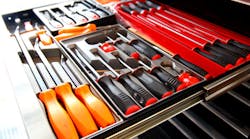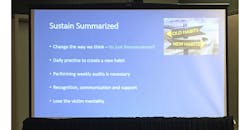What if you could spot abnormalities in your work environment in 30 seconds or less? Or you knew where your tools and other instruments were at all times because they had a specific home and they resided there when not in use? Or you went home from the job in a great frame of mind because you were productive, with little wasted time slowing you down?
These scenarios all are potential benefits of well-executed 5S, a workplace organization system that operational excellence consultant Todd Tommaney describes as one of the building blocks of lean.
Tommaney works with manufacturers via Catalyst Connection, a consulting and training organization in Pennsylvania as well as a Manufacturing Extension Partnership center in that state. Earlier this month, Tommaney provided a deep-dive session into 5S at Manufacturing & Technology, an IndustryWeek event. He was joined by John Ciora, plant manager at Schroeder Industries.
The Meaning of 5S
5S is an acronym of sorts for five words that begin with the letter S: sort, set in order, shine, standardize and sustain. Some organizations tout "safety" as a sixth "S," but "we believe health and safety is an output of the first five," Tommaney said.
In advance of addressing each "S" in 5S individually, the consultant provided some initial words of advice for workplaces interested in implementing 5S. Put together a team that goes to the location being worked on, he said. That team should include:
- Process owners. Owners understand the needs of the area. Moreover, "without their buy in, (5S) will fail," Tommaney said.
- Maintenance personnel. They can do quick fixes.
- Outside employees. External input can provide fresh perspective.
- Department manager. This assures quicker decisions.
- Facilitator. A facilitator makes sure the steps are followed and keeps the effort moving forward.
The next step is to gather information. Map current locations and take "before" photos.
First Comes 'Sort'
The goal of the sort procedure is to keep what is needed in the targeted area and remove what is not. Do you need 16 wrenches? Is this item ever used and how frequently? Visibly red tag items that aren't needed or are in the wrong place. Dispose of the unneeded items and move the others to a holding area.
Now 'Set in Order'
Once the unnecessary has been removed, it becomes time to find a place for the necessary. Determine the best locations, keeping in mind point of use and frequency of use, ease of access and return, and safety. Eliminate wasted movement, reaching, effort.
Tommaney emphasized that process owners are mandatory in location selection.
He also encouraged the use of visual cues – shadow boards are one example – that clearly highlight the difference between a normal and abnormal condition.
Time to 'Shine'
Clean the target area and everything in it, not simply for the sake of housekeeping but to create a new standard. Make the target area easy to keep clean, providing the right tools and supplies, and – importantly – addressing any safety concerns.
Moreover, this daily cleaning – and it should be done every shift, Tommaney said – is an inspection process as well. It presents an opportunity to check if everything is where it should be and if the anything needs replacing or repair.
'Standardize' with Rules
Develop rules to maintain the first three S's in 5S. That means creating red-tag procedures, as well as rules around locations, numbers and positions of items, and cleaning schedules and procedures. Make the procedures visual and the standards easy to understand.
The standards help ensure that 5S becomes an essential part of daily work, Tommaney explained. 5S ultimately shifts thinking from a "fix it" mode to a "control it" mode, and it enables workers to manage and control their area.
'Sustain' Those Gains
The best means to make this happen is to stick to the rules, absolutely. Daily practice develops into new habits. Perform weekly audits, and recognize and support adherence to the new standards.






